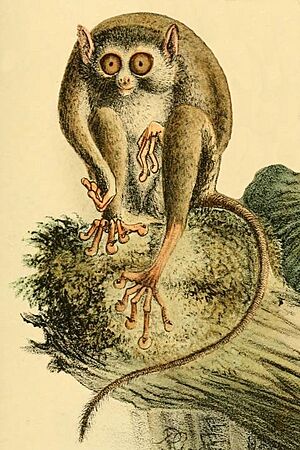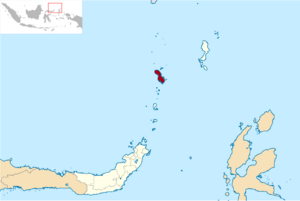Sangihe tarsier facts for kids
Quick facts for kids Sangihe tarsier |
|
|---|---|
 |
|
| Conservation status | |
| Scientific classification | |
| Genus: |
Tarsius
|
| Species: |
sangirensis
|
 |
|
| Sangihe tarsier range | |
The Sangihe tarsier (Tarsius sangirensis) is a tiny primate that lives on Sangir Island in Indonesia. This island is about 200 kilometers (124 miles) northeast of Sulawesi. People sometimes call it the Sangihe Island tarsier. In 2008, scientists realized that tarsiers living on nearby Siau Island were a different species, now called the Siau Island tarsier. Local people on Sangihe Island call these tarsiers Senggasi or Higo.
Contents
Sangihe Tarsier Classification
Scientists group living things into categories. This is called taxonomy. The Sangihe tarsier was first named as its own species in 1896 by Adolf Meyer. Later, some scientists thought it was a type of spectral tarsier.
However, today it is known as a unique species. The Siau Island tarsier was once thought to be the same as the Sangihe tarsier. But in 2008, it was found to be a separate species. Scientists still discuss how to best classify different types of tarsiers.
What Does the Sangihe Tarsier Look Like?
The Sangihe tarsier has several special features. It has large, round, forward-facing eyes that are pale chestnut in color. Its fingers and toes are long, as are its ankle bones (tarsus).
This is a very small primate. It usually weighs between 100 and 120 grams (about 3.5 to 4.2 ounces). It has sharp teeth because it only eats meat. Its tail is much longer than its body. The tail helps it stay balanced when sitting.
The fur on its upper body is yellowish-brown with dark gray at the base. Its underside is a dull white with a light gray base. Tarsiers cannot move their eyes. But they can turn their heads all the way around, 180 degrees! You can tell this species apart by the amount of fur on its tail. Its calls are also unique. The Sangihe tarsier's tail has thin fur on top. It does not have scales underneath.
Where Do Sangihe Tarsiers Live?
The Sangihe tarsier lives only on the Sangihe Islands in Indonesia. These islands are small, covering only 547 square kilometers (211 square miles). They prefer forests that have never been cut down. But they can also live in forests that are regrowing.
Sometimes, they are found in scrubland or coconut farms. They can even be seen in some farming areas. However, scientists are not sure if these tarsiers are truly thriving in farm areas. All tarsiers need warm, humid places to live. They need at least 50% humidity.
Sangihe Tarsier Behavior and Life
Sangihe tarsiers may have one partner for life (monogamous). Or they might have multiple partners (polygamous). They often live alone or in small groups. These groups usually have 2 to 6 tarsiers. They are often made up of parents and their young.
Scientists do not know much about their specific mating habits. They usually give birth to one baby at a time. Male and female tarsiers look very similar. They are nocturnal, meaning they are active at night. This makes them hard to study.
Most tarsiers are quiet animals. They mostly make chirping sounds. Males often chirp when they are trying to find a mate. They also communicate a lot using scent.
What Do Sangihe Tarsiers Eat?
Sangihe tarsiers mainly eat insects. These include grasshoppers and beetles. Sometimes, they eat small animals like lizards. Tarsiers are the only primates that eat only meat.
They have a simple and short digestive system. They do not search for insects like some other insect-eating animals. Instead, they sit and wait for prey. Once they see an insect, they grab it with their hands. They might also leap to catch it.
Protecting the Sangihe Tarsier
The Sangihe tarsier is listed as an endangered species. This means it is at high risk of disappearing forever. It is also protected under an international agreement called CITES.
Currently, there are no special programs to protect this tarsier. There are also not many nature reserves where it lives. It is very hard to keep these tarsiers safe outside of their natural home. They do not do well in zoos or other captive places.
Since we do not know much about their reproduction, there are no breeding programs yet. Scientists have suggested ways to better protect them. These ideas include creating more safe places for them. They also suggest activities like tracking tarsiers. This could help local tourism and the economy. Experts also recommend teaching people how to manage their land. This would help the tarsiers survive.
Threats to Sangihe Tarsiers
The number of Sangihe tarsiers is estimated to be between 1,505 and 52,734. It is hard to get exact numbers because of cloud cover over their home. Natural threats include birds, snakes, and the giant civet. Mount Awu, an active volcano on the island, is also a natural danger.
People also cause threats to these tarsiers. These include losing their homes due to human activity. Introducing cats and dogs to the island is also a problem. More people living in their area also harms them. Finally, the pet trade, where tarsiers are caught and sold, is a big threat.


